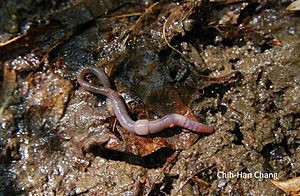Octolasion lacteum facts for kids
Quick facts for kids Octolasion lacteum |
|
|---|---|
 |
|
| A picture of an O.Lacteum in its natural moist environment | |
| Scientific classification | |
| Genus: |
Octolasion
|
| Species: |
lacteum
|
Octolasion lacteum is a type of earthworm found in the genus Octolasion. These worms live deep under the soil in moist places. They eat nutrients found in the soil. You can find them in places like New Zealand, especially in West Coast and Canterbury soils.
Unlike many other worms, O. lacteum can live in soil that is a bit acidic. They can also survive in soil that doesn't have as much organic matter. These worms play important roles in nature. They can help the soil, but sometimes they can also cause problems for other living things.
For example, after a dry period, they help the soil become healthier. They add more carbon dioxide to the soil. Their waste also provides good nutrients for plants. However, they can sometimes take too much carbon from the soil. This means plants have less carbon, which can upset the food web. These worms reproduce in a special way called parthenogenesis.
Contents
What is Octolasion lacteum?
Octolasion lacteum is a species of earthworm. It belongs to the family Lumbricidae. These worms were first found in New Zealand in the 1970s. Scientists discovered them in a garden. An interesting fact about their DNA is that it can handle high levels of radiation.
Where do they live?
Most O. lacteum worms live deep under the soil. They prefer places that are very moist. You can often find them in muddy soil. These worms are quite tough. They can live in many different environments.
They can survive in acidic soil, even with a pH of 4.7. They also do well in soils with less organic matter. This is different from many other worm species. O. lacteum eats nutrients from the soil itself. Other worms often eat dead leaves on the surface.
Sometimes, these worms compete with plants for food. If there are too many worms, they might eat nutrients that plants need to grow. For O. lacteum to thrive, the environment needs to be moist and muddy. They can even survive in areas with high radiation.
How do they help or harm nature?
Earthworms are very important for the environment. O. lacteum helps bring carbon levels back up in the soil after a drought. Carbon is vital for plants to grow. They also help increase mineral nitrogen in the soil. Nitrogen is another key nutrient for healthy soil.
The waste that these worms produce also adds nutrients to the soil. This helps plants and trees grow better. Healthy soil means better plants and trees. These are used by almost every human and animal on Earth.
However, Octolasion lacteum can sometimes be a problem. In some places, they can become an invasive species. This means they take over. They might suck up too much carbon from the soil. This leaves less carbon for trees and other plants. This can harm the local environment.
How do they reproduce?
Most worms in the Lumbricidae family reproduce in a special way. It's called cross parthenogenesis. Parthenogenesis is a type of asexual reproduction. This means the egg cell does not need to be fertilized by a male. It's like making a copy of themselves.
The best time for these worms to reproduce is in spring or autumn. This is when the soil is moist. Moist conditions are perfect for the worms to survive and have babies.

